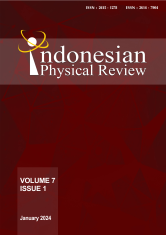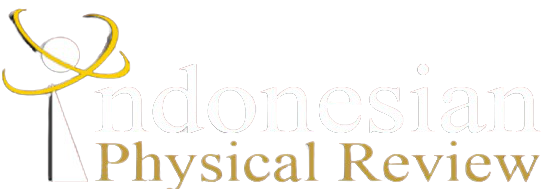GEOMETRICAL OPTICS AS AN ABELIAN U(1) GAUGE THEORY IN A VACUUM SPACE-TIME
DOI:
10.29303/ipr.v7i1.278Downloads
Abstract
As a consequence that geometrical optics (the eikonal equation) can be derived from Maxwell’s equations and Maxwell’s theory is nothing but an Abelian U(1) gauge theory, we propose that geometrical optics could also be treated as an Abelian U(1) gauge theory. We formulate geometrical optics as an Abelian U(1) gauge theory in a (3+1)-dimensional vacuum space-time as an approximation of the weak field. We show the explicit form of the phase, the gauge potential, and the field strength tensor related to the refractive index. We calculate numerically the refractive index and the magnetic field using the suitable parameters that we choose to mimic the real condition of nature. We obtain (without unit) the values of the refractive index  =1.0001 to represent a vacuum space-time and the amplitude Ï = 0.55853 related to magnitude of the magnetic field  = 0.10452 to represent the weak field.  The view of geometrical optics as gauge theory could be generalized or related to topological field theory where geometrical optics could have a topological structure in the case of the weak field.
Keywords:
Geometrical optics, Abelian U(1) gauge theory, Eikonal equation, Vacuum space-time, Weak field, TopologyReferences
L. D. Landau , E. M. Lifshitz, “The Classical Theory of Fieldsâ€, Pergamon Press, 1994.
The distance between two nearest points in the plane wave having the same phase is equal to a wavelength. In other words, the planes in the plane waves represents the wavefront, spaced a wavelength apart (see David Halliday, Robert Resnick, “Fundamentals of Physicsâ€, John Wiley & Sons, 1976).
L. D. Landau, E. M. Lifshitz, “Electrodynamics of Continuous Mediaâ€, Pergamon Press, 1984.
A. K. Ghatak, K. Thyagarajan, “Contemporary Opticsâ€, Plenum Press, 1978.
Ramamurti Shankar, “Fundamental of Physics II: Electromagnetism, Optics, and Quantum Mechanicsâ€, Yale University Press, 2016.
Charles W. Misner, Kip S. Thorne, John Archibald Wheeler, “Gravitationâ€, W. H. Freeman and Company, 1973, p.573.
L. D. Landau, E. M. Lifshitz, “Quantum Electrodynamicsâ€, Elsevier Ltd, 1982.
Alexander B. Balakin, Alexei E. Zayats, “Non-minimal Einstein-Maxwell theory: the Fresnel equation and the Petrov classification of a trace-free susceptibility tensorâ€, ArXiV, https://arxiv.org/pdf/1710.08013.pdf, 2018.
A. B. Balakin, A. E. Zayats, “Ray Optics in the Field of a Non- minimal Dirac Monopoleâ€, Gravitation and Cosmology, Vol. 14, No. 1, pp. 86-94, 2008.
Arnold Sommerfeld, “Optics, Lectures on Theoretical Physicsâ€, Volume IVâ€, Academic Press, 1949.
Max Born, Emil Wolf, “Principles of Opticsâ€, Pergamon Press, 1993.
J. L. Synge, “Geometrical Mechanics and de Broglie Wavesâ€, Cambridge University Press, 2010.
Antonio F. Ranada, “A Topological Theory of the Electromagnetic Fieldâ€, Letters in Mathematical Physics 18: 97-106, 1989.
Dimitar Simeonov, “On some properties of the electromagnetic field and its interaction with a charged particleâ€, ArXiV, https://arxiv.org/pdf/2004.09273.pdf, 2020.
Wikipedia.org, “Amplitudeâ€.
H. J. Pain, “The Physics of Vibrations and Wavesâ€, John Wiley & Sons, 1983.
Antonio F Ranada, “Topological electromagnetismâ€, J. Phys. A: Math. Gen. 25 (1992) 1621-1641.
Edward M. Purcell, David J. Morin, “Electricity and Magnetismâ€, Cambridge University Press, 2013. Roald K. Wangsness, “Electromagnetic Fieldsâ€, John Wiley & Sons, 1986.
A. F. Ranada, A. Tiemblo, “A Topological Structure in the Set of Classical Free Radiation Electromagnetic Fieldsâ€, ArXiV, arXiv:1407.8145v1 [physics.class-ph], 2014.
Roman Jackiw, “Lectures on Fluid Dynamicsâ€, Springer, 2002.
J. F. Nye, “Natural Focusing and Fine Structure of Lightâ€, IOP Publishing Ltd, 1999.
The complex eikonal equation in a 3-dimensional space where the eikonal, ψ1, is treated as a complex scalar field is considered (see A. Wereszczynski, Knots, “Braids and Hedgehogs from the Eikonal Equationâ€, ArXiV, https://arxiv.org/pdf/math-ph/0506035v1.pdf, 2018).
Miftachul Hadi, “Knot in geometrical opticsâ€, and all references therein, viXra, https://vixra.org/abs/2207.0114, 2022.
Miftachul Hadi, “Geometrical optics as U (1) local gauge theory in a flat space-timeâ€, OSF, https://osf.io/zpxkg, 2023.
Eugene Hecht, “Opticsâ€, Addison-Wesley, 2002.
Miftachul Hadi, “Knot in weak-field geometrical opticsâ€, and all references therein, OSF, https://osf.io/e7afj/, 2023.
License

This work is licensed under a Creative Commons Attribution-NonCommercial-ShareAlike 4.0 International License.
Authors who publish with Indonesian Physical Review Journal, agree to the following terms:
- Authors retain copyright and grant the journal right of first publication with the work simultaneously licensed under a Creative Commons Attribution-ShareAlike 4.0 International Licence (CC BY SA-4.0). This license allows authors to use all articles, data sets, graphics, and appendices in data mining applications, search engines, web sites, blogs, and other platforms by providing an appropriate reference. The journal allows the author(s) to hold the copyright without restrictions and will retain publishing rights without restrictions.
- Authors are able to enter into separate, additional contractual arrangements for the non-exclusive distribution of the journal's published version of the work (e.g., post it to an institutional repository or publish it in a book), with an acknowledgment of its initial publication in Indonesian Physical Review Journal.
- Authors are permitted and encouraged to post their work online (e.g., in institutional repositories or on their website) prior to and during the submission process, as it can lead to productive exchanges, as well as earlier and greater citation of published work (See The Effect of Open Access).





